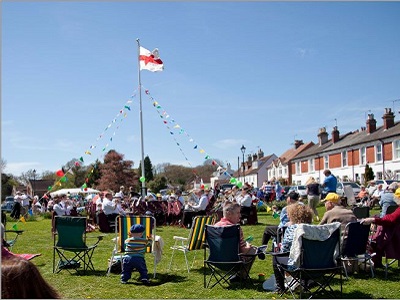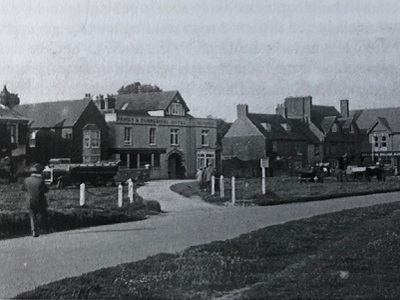Stop 1: The Flagpole-Information
Today, the Village Green is probably the most characteristic feature of Rowlands Castle. In many ways, it is the centre of village life. As you look around clockwise from the flagpole, first identify the Church on the Green, moving your eyes clockwise, there is a line of houses of historic significance, two public houses, and further along shops and other services. At the end of the Village Green, there is the railway bridge which carries trains from Portsmouth to Waterloo. Moving on, there are more shops and the high flint wall of Deerleap House.

At the centre of the Village Green, where you are standing, there is a prominent flagpole which might well have a flag flying as you stand by it. If so, look at its base and you will see the occasion for which the flag is being flown, written by the village flag mistress.
There are several stops around the Village Green where you will learn more about some of the history and features of the village.
The area that is now Rowlands Castle, seems to have been continuously inhabited since the end of the last ice age when our ancestors ventured north. The Romans built villas here and probably manufactured pots, tiles and bricks. Rowlands Castle was a regionally important centre for pottery manufacture, the product being known as “Rowlands Castle Ware”.
A Motte and Bailey Castle was built here after the Norman Invasion of 1066 and it lay on the route north from the south coast.
The area that is now the Village Green, has a characteristic V or funnel shape, being wider at its western end and narrowing to the east. The shape is typical of many around the edge of the Forest of Bere which in Saxon and Norman times stretched from the River Meon to Rowlands Castle. The forest was nominally “waste” (unproductive) land of local manors (Chawton-cum-Idsworth, Leigh Park and Stansted) and was used by local people to graze their livestock, in particular in the autumn when the pigs foraged for acorns known as pannage. At the end of the season the livestock were rounded up and driven down the funnel into a stockade at the narrow end of the Village Green and collected by their owners. They were then driven to their respective farms along droveways, for example, to Wellsworth and Idsworth.

In 1740, a man called John Smith built a cottage and Brew House, now known as the Fountain Inn and now much enlarged. The line of houses were then built along the north of the Village Green and a large property to the south called Deerleap.
By the 1841 Census, properties surrounded the area that is now the Village Green, which, before the Railway was built, extended beyond the Railway Bridge and up Woodberry Lane.
In those times, Rowlands Castle was not a genteel place, with smugglers plying their trade.
Two major fairs were held on the Village Green during the 1700’s up until 1873. One of these was on the 12th May and the other on the 12th of November. These fairs fulfilled a number of purposes, including the sale of horses and livestock as well as the hiring of servants and farmworkers for the Estates of Leigh Park, Stansted, Idsworth, Chalton and Warblington.
The coming of the Railway in 1859 brought about many social changes but the Green continued to have a central place in village Life.
The Village Green played an important part in Operation Overlord in the run-up to D- Day in June 1944. Tanks were stationed on the Village Green which had been prepared for them by surfacing it with bomb-damaged rubble from Portsmouth.
A new sort of Village Fair was initiated by the Rowlands Castle Association in 1973 and this is still very vibrant and well attended. The Green continues to be the centre of village events and commemorations; most recently, in 2022, it was the site of the Platinum Jubilee Celebrations for Her Majesty Queen Elizabeth II.